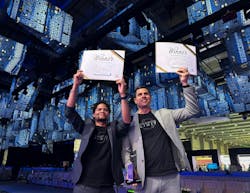Startup Turns Concrete into a Carbon Capture Solution
Cement and concrete production generates as much as 9% of all human CO2 emissions. But what if concrete could go from environmental liability to environmental asset? That’s what startup Carbon Limit aims to achieve with its CaptureCrete product.
Here’s how it works: A powder additive, CaptureCrete consists of natural minerals that are highly reactive to carbon dioxide. Once that powder is added during concrete manufacturing, the minerals then pull CO2 from the air into the concrete, where it’s mineralized and stored. The concrete becomes a carbon capture solution.
“The minerals are a magnet for CO2,” says Tim Sperry, founder and CEO, Carbon Limit.
As a result, CaptureCrete “lowers the overall carbon footprint of a project,” he says. In addition, the mineralized CO2 improves the performance and compressive strength of the concrete, potentially reducing long-term maintenance, Sperry says.
Carbon Capture Through Concrete Additives
CaptureCrete-embellished concrete absorbs CO2 for about the first six months to a year. “The concrete is like a sponge,” Sperry explains. “It pulls in CO2 until it’s almost full, then can’t pull in any more.” The amount of captured emissions depends on the particular concrete mix for each project, he adds.
What happens to the mineralized CO2 if the building gets torn down or the road gets torn up? “Even if you break the concrete down, the CO2 stays intact as a solid material,” Sperry says. “It’s stable, which is the best part. You permanently store the CO2.” That concrete also could have a second life as a recycled aggregate.
The potential uses are vast, Sperry says: residential, commercial, public, private. For instance, in South Florida, where Carbon Limit is based, codes require concrete block construction—concrete blocks that can be produced using CaptureCrete.
“Our technology can be easily integrated into concrete blocks, concrete foundational slabs, concrete subfloors, concrete tiles,” Sperry says. Carbon Limit is currently in the process of testing its product in rebar-reinforced concrete.
Residential Use
Recently, Carbon Limit entered the residential market through a partnership with NCP Industries, an engineering and manufacturing company that produces building materials. NCP initially will use CaptureCrete in lightweight veneer stone for outdoor projects.
With customers like NCP, Carbon Limit provides the formula for a more sustainable, carbon-capturing concrete and tells them the materials they need and how much to add to their concrete mix. But Carbon Limit leaves the concrete making to its customers.
“Concrete producers are way better and more efficient at making these materials. They already know what they’re doing. We don’t add a facility or process. We don’t want to re-create the wheel,” Sperry says. “A customer can use CaptureCrete overnight. It’s a simple technology that’s easy to apply.”
Carbon Limit also performs quality assurance and control to quantify the project’s environmental impact, ensuring the materials capture CO2 as intended. Plus, projects that use CaptureCrete generate carbon credits—which Carbon Limit manages and sells, sharing the funds with its customers.
At his previous startup, Sperry created an additive for paint so that it could absorb CO2 and air pollutants. He realized the potential impact of negative emissions technology could reach beyond paint, and in 2020, he founded Carbon Limit as a carbon capture company for the built environment.
Carbon Limit has quickly racked up investors and customers. After getting its start with the TechStars Accelerator program in 2021, Carbon Limit participated in Google for Startups Accelerators in 2022. The company has gained funding from the U.S. Department of Defense and the U.S. Army Corps of Engineers, two of the world’s largest users of concrete. Minnesota Department of Transportation has used CaptureCrete on a highway paving project.
Meanwhile, the accolades have poured in. In 2023, Carbon Limit was named the winner of GreenBiz’s Climate Tech Startup of the Year, Big 5 FutureTech Summit’s Start-up City Pitch Competition, and Cityscape Global’s Innovation Challenge—to name a few.
“We see no reason every concrete can’t be a carbon-capturing concrete,” Sperry says.



